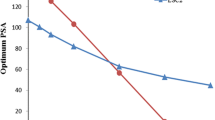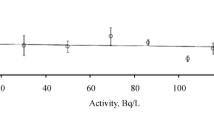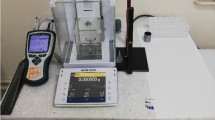Abstract
Methods for the evaluation of the accidental coincidences counting rates in triple-to-double coincidences ratio (TDCR) liquid scintillation (LS) measurements have been proposed recently. This study shows how these corrections can be extended to two detector systems, such as commercial LS counters, or four-detector systems used for the compton source efficiency tracing (CSET) method. The significance of performing corrections for accidental coincidences in low-activity LS counting or TDCR measurements is demonstrated. The impact of accidental coincidences on the determination of half-life of radioisotopes is also shown.




Similar content being viewed by others
References
Donald LH (1974) Applications of liquid scintillation counting. Elsevier, Amsterdam
Dutsov C, Cassette P, Sabot B, Mitev K (2020) Evaluation of the accidental coincidence counting rates in TDCR counting. Nuclear instruments and methods in physics research section a: accelerators, spectrometers, detectors and associated equipment. Elsevier, Amsterdam
Benoit Sabot, Chavdar Dutsov, Philippe Cassette, Krasimir Mitev, Performance of portable TDCR systems developed at LNE-LNHB (2022) Nuclear instruments and methods in physics research section a: accelerators, spectrometers, detectors and associated equipment, To be published
Broda R, Pochwalski K, Radoszewski T (1988) Calculation of liquid-scintillation detector efficiency. Int J Radiat Appl Intstrum A Appl Radiat Isot 39(2):159–164
Birks JB (1964) The theory and practice of scintillation counting. Pergamon Press, Oxford
Cassette P, Do P (2008) The Compton source efficiency tracing method in liquid scintillation counting: a new standardization method using a TDCR counter with a Compton spectrometer. Applied radiation and isotopes (Vol. 66, Issues 6 7, pp. 1026–1032). Elsevier, Amsterdam
Bignell, L. J., Mo, L., Steele, T., & Hashemi-Nezhad, S. R. (2013). The Zero Model by Using Coincidence Scintillation (ZoMBieS) Method of Absolute Radioactivity Measurement. In IEEE Transactions on Nuclear Science (Vol. 60, Issue 5, pp. 4007–4014). Institute of Electrical and Electronics Engineers (IEEE). https://doi.org/10.1109/tns.2013.2275990
Dutsov C, Cassette P, Mitev K, Sabot B (2021) In quest of the optimal coincidence resolving time in TDCR LSC. Nucl Instrum Meth A 987:164846
Lombardi P, Ortica F, Ranucci G, Romani A (2013) Decay time and pulse shape discrimination of liquid scintillators based on novel solvents. Nuclear instruments and methods in physics research section a: accelerators, spectrometers, detectors and associated equipment. Elsevier, Amsterdam
Jordanov V, Cassette P, Dutsov Ch, Mitev K (2020) Development and applications of a miniature TDCR acquisition system for in-situ radionuclide metrology. Nucl Instrum Meth A 954:161202
M. A. Kellett and O. Bersillon (2017) The Decay Data Evaluation Project (DDEP) and the JEFF-3.3 radioactive decay data library: Combining international collaborative efforts on evaluated decay data. In: A. Plompen, F.-J. Hambsch, P. Schillebeeckx, W. Mondelaers, J. Heyse, S. Kopecky, P. Siegler, and S. Oberstedt (eds) EPJ Web Conferences 146 p 02009
Bouchard J, Cassette P (2000) MAC3: an electronic module for the processing of pulses delivered by a three photomultiplier liquid scintillation counting system. Applied Radiation and Isotopes (Vol. 52, Issue 3, pp. 669–672). Elsevier, Amsterdam
Dutsov C, Mitev K, Cassette P, Jordanov V (2019) Study of two different coincidence counting algorithms in TDCR measurements. Appl Radiat Isot 154:108895
Bobin C, Thiam C, Bouchard J, Jaubert F (2010) Application of a stochastic TDCR model based on Geant4 for Cherenkov primary measurements. Applied Radiation and Isotopes (Vol. 68, Issue 12, pp. 2366–2371). Elsevier, Amsterdam
Broda R, Cassette P, Kossert K (2007) Radionuclide metrology using liquid scintillation counting. Metrologia (Vol. 44, Issue 4, pp. S36–S52). IOP Publishing, Bristol
Acknowledgements
The authors thank Dr Philippe Gervais from CEA/SHFJ for providing sample of 18F solution. This work was funded by the French national metrology institute: Laboratoire National de Métrologie et d’Essais (LNE). The authors are indebted to Dr Karsten Kossert for providing the 53Mn sample. The measurement of Po-209 samples were performed in the framework of DORN project. The authors thank Margot Corbel from CEA/LNHB for the preparation of the 209Po sample.
Funding
This work is supported by the Bulgarian National Scientific Research Fund under contract KP-06-H38/9 from 06.12.19 (TDCX).
Author information
Authors and Affiliations
Corresponding author
Ethics declarations
Conflict of interest
All authors declare that they have no conflicts of interest.
Additional information
Publisher's Note
Springer Nature remains neutral with regard to jurisdictional claims in published maps and institutional affiliations.
Rights and permissions
About this article
Cite this article
Dutsov, C., Sabot, B., Cassette, P. et al. Significance of the corrections for accidental coincidences in liquid scintillation counting measurements. J Radioanal Nucl Chem 331, 3303–3311 (2022). https://doi.org/10.1007/s10967-022-08316-y
Received:
Accepted:
Published:
Issue Date:
DOI: https://doi.org/10.1007/s10967-022-08316-y




